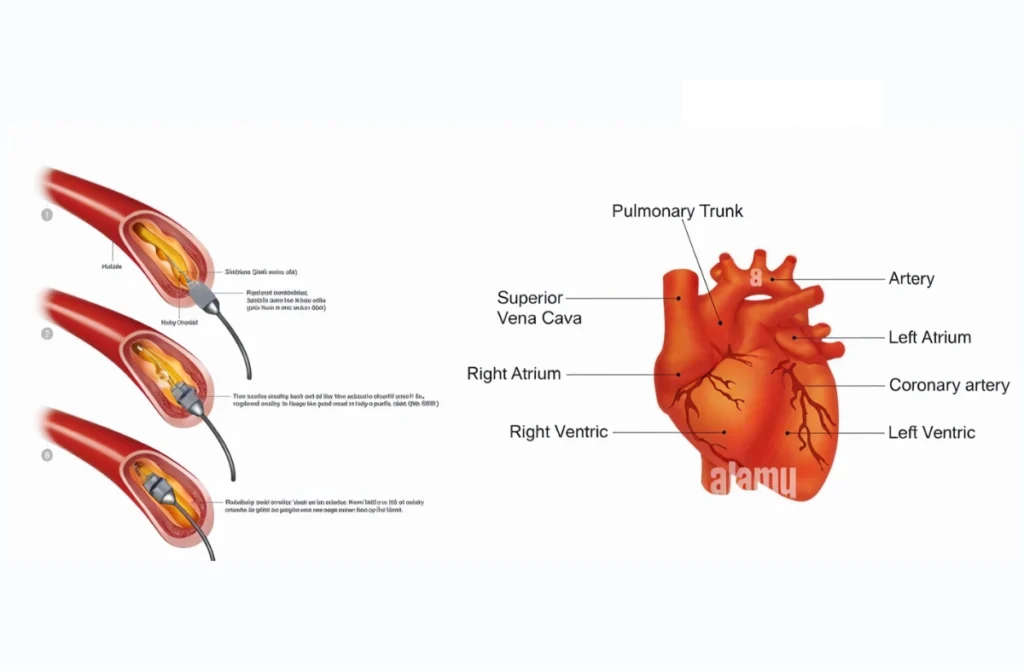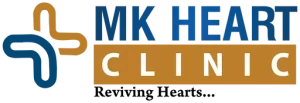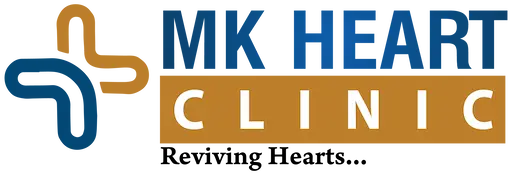Rotational Atherectomy (Rotablation) is a minimally invasive procedure used to treat calcified and heavily stenosed (narrowed) coronary arteries. It involves using a high-speed rotating diamond-coated burr to shave off the calcified plaque and clear the artery lumen, improving blood flow to the heart.
Typically, the rotational atherectomy treatment in Chennai is performed in combination with balloon angioplasty and stenting, and is performed through a catheter inserted through the femoral artery in the leg.
This procedure is used in patients with complex coronary artery disease who are not suitable for traditional angioplasty treatment, and has been shown to be effective in improving symptoms, reducing the need for repeat procedures, and improving long-term outcomes.
What is Rotational Atherectomy?
Rotational Atherectomy Treatment in Chennai, also known as Rotablation, is a minimally invasive procedure used to treat severe coronary artery disease. This treatment is particularly effective for patients with heavily calcified plaques that cannot be adequately treated with traditional balloon angioplasty or stenting. The procedure involves the use of a diamond-tipped burr that rotates at high speeds to pulverize the calcified plaque into microscopic particles, which are then safely washed away by the bloodstream.
The Need for Rotational Atherectomy
The primary need for Rotational Atherectomy Treatment in Chennai arises in patients with complex coronary artery disease, where traditional methods fail to effectively clear the blockages. Calcified plaques pose a significant challenge in coronary interventions because they are rigid and less responsive to conventional treatments. Rotablation offers a specialized approach to address these hard plaques, ensuring better outcomes for patients.

Cause of Rotational Atherectomy Treatment in Chennai
The primary cause of these calcium deposits is the build-up of plaque, which is made up of fatty substances, cholesterol, and other substances.
Over time, this plaque can harden and restrict the flow of blood to the heart, leading to chest pain (angina), heart attack, and other heart-related issues.
This is where rotational atherectomy treatment in Chennai is performed using a rotating burr or diamond-tipped device to break up the calcium deposits in blood vessels, particularly in the coronary arteries besides restoring normal blood flow to the heart.
Who is the Right Doctor for Rotational Atherectomy?
Dr. M. Kathiresan, a renowned cardiologist specializing in rotational atherectomy treatment, is the right doctor to consult in Chennai. With extensive experience and expertise in this advanced cardiac procedure, Dr. Kathiresan offers comprehensive care to patients seeking effective treatment for coronary artery disease. His commitment to excellence and patient-centric approach make him a trusted choice for rotational atherectomy in Chennai.
Diagnosis
Diagnosis of the need for rotational atherectomy treatment in Chennai is typically done through a combination of medical tests, including:
- Coronary angiogram.
- Intravascular ultrasound (IVUS).
- Computed Tomography (CT) angiogram.
- Stress test.
Based on the results of these tests, a doctor can determine whether a rotational atherectomy procedure is an appropriate treatment option and which vessels may need to be treated.
Treatment
The rotablation procedure is performed by an interventional cardiologist and typically takes 1-2 hours. It is performed in a hospital or outpatient setting using local anaesthesia and mild sedation.
During the rotational atherectomy treatment in Chennai, a small incision is made in the groin or wrist to allow access to the affected coronary artery. A catheter is then inserted into the artery and guided to the site of the calcium deposit. The area around the calcium deposit is prepared for the procedure.
This may involve injecting a dye to visualize the blood vessels and using imaging equipment to guide the rotablation device consisting of a rotating diamond-tipped burr, which is activated and used to break up the calcium deposit. The fragments are then removed from the bloodstream through the catheter. The patient’s vital signs and heart function are monitored during the procedure to ensure there are no complications.
After the procedure is performed, the catheter is removed and then the incision is closed. The patient will be monitored for a few hours to ensure there are no complications. Recovery time after rotablation is typically short, with most patients able to resume normal activities within a few days.
Rotational Atherectomy Procedure
- Local Anesthesia: The patient is usually given local anesthesia at the insertion site, often the femoral or radial artery.
- Guidewire Placement: A guidewire is threaded through the blocked artery under X-ray guidance to reach the location of the plaque.
- Rotational Atherectomy: The rotational atherectomy device, equipped with a rotating burr, is advanced over the guidewire to the site of the blockage.
- Plaque Modification: The rotating burr grinds and modifies the calcified plaque, creating small particles that can be easily carried away in the bloodstream.
What is the Normal Success Rate for this Procedure?
The success rate of rotational atherectomy system, a procedure used to treat calcified coronary artery blockages, can vary depending on individual patient factors and the complexity of the case. In skilled hands, this procedure can be highly effective in improving blood flow to the heart. It’s essential to consult with a specialist like Dr. M. Kathiresan in Chennai to assess your specific condition and discuss the expected success rate and potential risks.
Read also: Transcatheter Aortic Valve Replacement In Chennai
Benefits of Rotational Atherectomy Treatment in Chennai
Enhanced Treatment for Complex Cases
One of the significant benefits of Rotational Atherectomy Treatment in Chennai is its effectiveness in treating complex and calcified coronary artery disease. Patients who have not responded well to traditional angioplasty or have experienced restenosis (re-narrowing of the artery) can benefit immensely from this procedure.
Improved Patient Outcomes
Clinical studies have shown that Rotational Atherectomy improves the success rates of subsequent interventions like balloon angioplasty and stenting. Patients undergoing this treatment typically experience better long-term outcomes, including reduced symptoms of angina (chest pain), improved exercise tolerance, and overall enhanced quality of life.
Minimally Invasive Approach
Rotational Atherectomy is a minimally invasive procedure, which means it involves smaller incisions, reduced pain, and shorter recovery times compared to traditional open-heart surgeries. This minimally invasive nature makes it a suitable option for high-risk patients who may not be ideal candidates for more invasive procedures.
Availability of Advanced Technology and Expertise
Chennai is home to some of the most advanced cardiac care facilities in India, equipped with the latest technology and staffed by highly skilled cardiologists and cardiac surgeons. The expertise available for Rotational Atherectomy Treatment in Chennai ensures that patients receive the best possible care and outcomes.
Risks
However, there are also potential risks associated with rotational atherectomy treatment in Chennai. They include:
- Infection/bleeding.
- Damage to blood vessels or surrounding tissue.
- Heart attack or stroke during or shortly after the procedure.
- Arrhythmia or irregular heartbeat.
- Allergic reaction to contrast dyes or medications used during the procedure.
Rotablation Angioplasty Cost in Chennai
Understanding the Costs
The cost of Rotational Atherectomy Treatment in Chennai can vary depending on several factors, including the hospital, the complexity of the case, and the specific needs of the patient. It is essential to have a clear understanding of the associated costs to make informed decisions about the treatment.
Factors Influencing Costs
- Hospital and Facility Fees: The choice of hospital can significantly impact the overall cost. Leading hospitals with advanced facilities and specialized cardiac units may charge higher fees.
- Surgeon’s Fees: The expertise and experience of the cardiologist or cardiac surgeon performing the procedure can also influence the cost.
- Procedure Complexity: The complexity of the patient’s condition and the extent of the calcification can affect the duration and difficulty of the procedure, thereby impacting the cost.
- Post-Procedure Care: Costs related to hospital stay, medications, and follow-up visits are additional factors to consider.
Comparing Costs with Other Treatments
When comparing the costs of Rotational Atherectomy Treatment in Chennai with other coronary interventions, it is essential to consider the long-term benefits and potential cost savings. While the initial cost of Rotablation may be higher than traditional angioplasty, the improved outcomes and reduced need for repeat procedures can result in overall cost savings for patients.
Insurance and Financial Assistance
Many health insurance plans cover Rotational Atherectomy Treatment in Chennai. Patients are encouraged to check with their insurance providers to understand the extent of coverage and any out-of-pocket expenses. Additionally, some hospitals offer financial assistance programs to help patients manage the costs associated with the treatment.
Rotational vs. Orbital Atherectomy: Choosing Effective Treatment in Chennai
When considering atherectomy for coronary artery disease, understanding the differences between rotational and orbital atherectomy is crucial. At leading cardiovascular centers in Chennai, like ours, both options are available.
Rotational Atherectomy
- Involves a high-speed rotating burr to remove plaque.
- Effective for calcified lesions.
- Offers precise control during the procedure.
- Utilizes a unique orbital motion for plaque modification.
- Well-suited for concentric lesions.
- Provides controlled, differential sanding for optimal results.
For personalized atherectomy treatment in Chennai, consult our expert cardiovascular team.
Facilities
Some of the technology and facilities that are typically used during a rotational atherectomy procedure:
- Rotablation device.
- Angiography or intravascular ultrasound.
- Catheterization laboratory.
- Local anaesthesia and mild sedation.
- Monitoring equipment.
- Recovery area.
Our Doctors
Dr. Kathiresan gives a comprehensive rotablation atherectomy treatment at a reasonable rotablation angioplasty cost. He helps to evaluate the patient’s condition, determine if rotablation is a suitable option, and oversee the procedure besides discussing the potential benefits and risks of the procedure with the patient. Moreover, he monitors the patient’s progress during and after the procedure to ensure a safe and successful outcome.
Understanding Rotational Atherectomy Risks: A Positive Perspective
Rotational atherectomy offers significant benefits, particularly for patients with complex coronary artery blockages. However, like any medical procedure, it carries potential risks. It’s essential to view these risks through a balanced lens to understand the overall advantages of this treatment option. Here’s an overview of CSI rotational atherectomy risks and how they can be minimized:
- Risk of Vessel Injury: Rotational atherectomy involves the use of a high-speed rotating burr to shave off plaque from the artery walls. This can cause small tears or injuries to the vessel, although the risk is low with skilled professionals.
- Embolization: A small amount of plaque may break off and travel to smaller vessels, potentially causing a blockage in distant parts of the heart. This risk can be mitigated by using embolic protection devices.
- Coronary Dissection: In rare cases, the burr may cause a tear in the coronary artery, leading to coronary dissection, which can further complicate the procedure. Monitoring and precautionary measures can reduce this risk.
- Bleeding and Infection: As with any procedure involving catheters, there is a slight risk of infection or bleeding at the insertion site. Proper sterilization and care can minimize these risks.
Despite these potential risks, CSI rotational atherectomy is a safe and effective procedure when performed by experienced cardiologists. The positive outcomes often outweigh the risks, making it an essential tool in treating coronary artery disease.
The Rotational Atherectomy Procedure: Navigating the Path to Wellness
Rotational atherectomy is often used when other treatments like balloon angioplasty or stent placement may not be sufficient, especially in cases of calcified lesions. By understanding the step-by-step process of this procedure, you’ll gain a deeper insight into how it helps restore proper blood flow to the heart.
Step-by-Step Overview of the Rotational Atherectomy Procedure:
- Preparation: The patient is typically sedated and a catheter is inserted into the femoral artery in the groin or radial artery in the wrist.
- Catheter Insertion: A guidewire is threaded through the coronary arteries, directing it to the site of the blockage.
- Rotational Atherectomy: A specialized rotating burr is attached to the catheter, which spins at high speeds to sand away the plaque buildup in the artery.
- Plaque Removal: The high-speed rotation shaves off the hardened plaque, making the artery wide enough for further treatments like balloon angioplasty or stenting.
- Post-Procedure Care: After plaque removal, the catheter is removed, and the patient is monitored for any complications. Additional treatments may be necessary depending on the severity of the blockage.
Understanding how rotational atherectomy works is vital for both patients and healthcare providers. It’s a procedure that focuses on restoring normal blood flow, significantly reducing the risk of heart attack or other cardiovascular issues.
Conclusion
Rotational atherectomy treatment in Chennai, led by Dr. Kathiresan, is crucial for managing severe coronary artery calcification that traditional procedures struggle to address. By utilizing advanced techniques like intravascular ultrasound (IVUS) and optical coherence tomography (OCT), Dr. Kathiresan ensures precise diagnosis and optimal treatment planning. This approach is especially beneficial for patients with complex lesions and chronic total occlusions, offering improved outcomes and relief from symptoms like persistent angina. Through his expertise and the latest technology, Dr. Kathiresan provides comprehensive care, enhancing the success rates and quality of life for individuals requiring rotational atherectomy in Chennai.
Read also: Transcatheter Mitral Valve Replacement In Chennai


